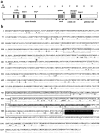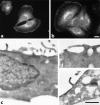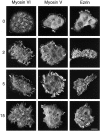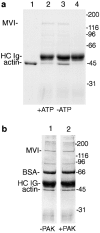The localization of myosin VI at the golgi complex and leading edge of fibroblasts and its phosphorylation and recruitment into membrane ruffles of A431 cells after growth factor stimulation
- PMID: 9852149
- PMCID: PMC2132970
- DOI: 10.1083/jcb.143.6.1535
The localization of myosin VI at the golgi complex and leading edge of fibroblasts and its phosphorylation and recruitment into membrane ruffles of A431 cells after growth factor stimulation
Abstract
Myosin VI is an unconventional myosin that may play a role in vesicular membrane traffic through actin rich regions of the cytoplasm in eukaryotic cells. In this study we have cloned and sequenced a cDNA encoding a chicken intestinal brush border myosin VI. Polyclonal antisera were raised to bacterially expressed fragments of this myosin VI. The affinity purified antibodies were highly specific for myosin VI by immunoblotting and immunoprecipitation and were used to study the localization of the protein by immunofluorescence and immunoelectron microscopy. It was found that in NRK and A431 cells, myosin VI was associated with both the Golgi complex and the leading, ruffling edge of the cell as well as being present in a cytosolic pool. In A431 cells in which cell surface ruffling was stimulated by EGF, myosin VI was phosphorylated and recruited into the newly formed ruffles along with ezrin and myosin V. In vitro experiments suggested that a p21-activated kinase (PAK) might be the kinase responsible for phosphorylation in the motor domain. These results strongly support a role for myosin VI in membrane traffic on secretory and endocytic pathways.
Figures








Similar articles
-
Rapid phosphorylation and reorganization of ezrin and spectrin accompany morphological changes induced in A-431 cells by epidermal growth factor.J Cell Biol. 1989 Mar;108(3):921-30. doi: 10.1083/jcb.108.3.921. J Cell Biol. 1989. PMID: 2646308 Free PMC article.
-
Myosin II is associated with Golgi membranes: identification of p200 as nonmuscle myosin II on Golgi-derived vesicles.J Cell Sci. 1997 Sep;110 ( Pt 18):2155-64. doi: 10.1242/jcs.110.18.2155. J Cell Sci. 1997. PMID: 9378765
-
Phosphorylation of myosin-binding subunit (MBS) of myosin phosphatase by Rho-kinase in vivo.J Cell Biol. 1999 Nov 29;147(5):1023-38. doi: 10.1083/jcb.147.5.1023. J Cell Biol. 1999. PMID: 10579722 Free PMC article.
-
Myosin VI: a multifunctional motor.Biochem Soc Trans. 2004 Nov;32(Pt 5):685-8. doi: 10.1042/BST0320685. Biochem Soc Trans. 2004. PMID: 15493988 Review.
-
Myosin VI, an actin motor for membrane traffic and cell migration.Traffic. 2002 Dec;3(12):851-8. doi: 10.1034/j.1600-0854.2002.31201.x. Traffic. 2002. PMID: 12453148 Review.
Cited by
-
Characteristics of light chains of Chara myosin revealed by immunological investigation.Proc Jpn Acad Ser B Phys Biol Sci. 2012;88(5):201-11. doi: 10.2183/pjab.88.201. Proc Jpn Acad Ser B Phys Biol Sci. 2012. PMID: 22687741 Free PMC article.
-
Myosin motors and not actin comets are mediators of the actin-based Golgi-to-endoplasmic reticulum protein transport.Mol Biol Cell. 2003 Feb;14(2):445-59. doi: 10.1091/mbc.e02-04-0214. Mol Biol Cell. 2003. PMID: 12589046 Free PMC article.
-
Myosin VI is required for targeted membrane transport during cytokinesis.Mol Biol Cell. 2007 Dec;18(12):4750-61. doi: 10.1091/mbc.e07-02-0127. Epub 2007 Sep 19. Mol Biol Cell. 2007. PMID: 17881731 Free PMC article.
-
Multiple proteins mediate IQGAP1-stimulated cell migration.Cell Signal. 2007 Sep;19(9):1857-65. doi: 10.1016/j.cellsig.2007.04.011. Epub 2007 May 5. Cell Signal. 2007. PMID: 17544257 Free PMC article.
-
Loss of cargo binding in the human myosin VI deafness mutant (R1166X) leads to increased actin filament binding.Biochem J. 2016 Oct 1;473(19):3307-19. doi: 10.1042/BCJ20160571. Epub 2016 Jul 29. Biochem J. 2016. PMID: 27474411 Free PMC article.
References
-
- Allan V. Role of motor proteins in organizing the endoplasmic reticulum and Golgi apparatus. Semin Cell Devel Biol. 1996;7:335–342.
-
- Avraham KB, Hasson T, Steel KP, Kingsley DM, Russell LB, Mooseker MS, Copeland NG, Jenkins NA. The mouse Snell's waltzerdeafness gene encodes an unconventional myosin required for structural integrity of inner ear hair cells. Nat Genet. 1995;11:369–375. - PubMed
Publication types
MeSH terms
Substances
LinkOut - more resources
Full Text Sources
Molecular Biology Databases

